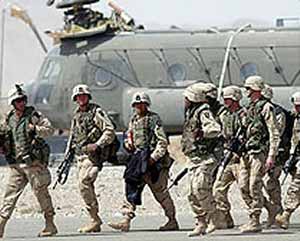| "The al Qaeda and Taliban
are free to surrender," Hilferty said. "We'd love to have them surrender,
but so far they've all decided to die. They have to surrender or die."
In Washington, a Bush administration
official said that U.S. troops in the valley were collecting DNA samples
from the bodies of some dead al Qaeda and Taliban fighters.
The official said samples
were being taken mainly from bodies of dead fighters who appear to be al
Qaeda leaders in an effort to identify them. It would not be possible to
collect samples from the hundreds who have been killed in the U.S. campaign
since the fighting began, the official said.
Also, he said, U.S. troops
are burying dead fighters, when it is possible, in the rough and cold terrain.
Several hundred Afghan forces,
along with 40 U.S. Special Forces, converged Wednesday on Shah-e-kot village
-- located in the valley with the same name. The village was heavily damaged
in the fighting.
The area around the village
was completely quiet as Apache attack helicopters crisscrossed the skies
on patrol.
According to military sources,
some al Qaeda and Taliban fighters escaped as allied forces closed on them.
Their numbers weren't known,
but it is believed some of the fighters may have slipped over the eastern
mountains into Pakistan or filtered to the west into Afghan cities that
have been Taliban strongholds.
"The coalition continues
to re-position forces, as we have from the very beginning," Hilferty said.
"But we still have about 1,500 soldiers on the ground in the objective
area, aggressively searching for the terrorists."
U.S. officials said Tuesday
that with Operation Anaconda winding down, U.S. troops were preparing to
turn their attention to pockets of opposition elsewhere in Afghanistan.
A senior U.S. military official
in Washington said nearly 600 American troops -- almost half the U.S. ground
force participating in Operation Anaconda -- had withdrawn. Most of the
U.S. troops were at Bagram air base north of the Afghan capital, Kabul,
and could be sent to fight elsewhere.
None of these additional
pockets -- mainly in southeastern Afghanistan -- are thought to be as large
as the one near Gardez, capital of Paktia province.
The United States is conducting
reconnaissance and intelligence operations to get a better idea of where
and how many al Qaeda and Taliban are in certain regions, the official
said. The initial estimate was that 200 enemy fighters were near Gardez,
but within days it had grown to 1,000.

|
